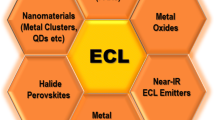Abstract
A short review is dedicated to the role of molecular oxygen and its active forms in generation of electrochemiluminescence (ECL). It is shown at the example of such widely used luminogens as luminol, lucigenin, acridine esters, acridane, and indoles that the role of O2 and its active forms, such as hydrogen peroxide, superoxide and hydroperoxide radicals in generation of ECL by organic compounds is largely reduced to oxidation of the initial luminogen or intermediates of its partial electrochemical preoxidation/prereduction. Such intermediates are most often particles in the doublet state (radical-cation, radical-anion, or free radicals) that form unstable emitter precursors of peroxide (dioxetanone) type under interaction with O2, hydrogen peroxide, or other active oxygen forms. It is also shown that the product of secondary transformations of active oxygen forms is singlet oxygen that may also be a radiation source as a result of cooperative transitions.
Similar content being viewed by others
References
Reshetnyak, O.V. and Błażejowski, J., in Elektrokhimiya organicheskikh soedinenii v nachale XXI veka (Electrochemistry of Organic Compounds at the Beginning of the XXIst Century), Gul’tyai, V.P, Krivenko, A.G, and Tomilov, A.P,, Eds., Moscow: Kompaniya Sputnik+, 2008, pp. 6–55.
Richter, M.M., Chem. Educator, 2002, vol. 7, p. 195.
Haapakka, K.E. and Kankare, J.J., Anal. Chim. Acta, 1982, vol. 138, p. 263.
Wilson, R., Akhavan-Tafti, H., De Silva, R., and Schaap, A.P., Electroanalysis, 2001, vol. 13, p. 1083.
Merenyi, G., Lind, J., and Eriksen, T.E., J. Am. Chem. Soc., 1986, vol. 108, p. 7716.
Merenyi, G., Lind, J., and Eriksen, T.E., J. Biolumin. Chemilumin., 1990, vol. 5, p. 53.
Easton, P.M., Simmonds, A.C., Rakishev, A., Egorov, A.M., and Candeias, L.R., J. Am. Chem. Soc., 1996, vol. 118, p. 6619.
Wilson, R., Akhavan-Tafti, H., DeSilva, R., and Schaap, A.P., Chem. Commun., 2000, p. 2067.
Mirkhalaf, F. and Wilson, R., Electroanalysis, 2005, vol. 17, no. 19, p. 1761.
Wilson, R., Akhavan-Tafti, H., DeSilva, R., and Schaap, A.P., Anal. Chem., 2001, vol. 73, p. 763.
McCapra, F., Pure Appl. Chem., 1970, vol. 24, p. 611.
McCapra, F., Acc. Chem. Res., 1976, vol. 9, p. 201.
Townshend, A., Analyst, 1990, vol. 115, p. 495.
Yang, M.-L., Liu, C.-Z., Hu, X.-H., He, P.-G., and Fang, Y.-Z., Anal. Chim. Acta, 2002, vol. 461, p. 141.
Legg, K.D. and Hercules, D.M., J. Am. Chem. Soc., 1969, vol. 91, p. 1902.
Haapakka, K.E. and Kankare, J.J., Anal. Chim. Acta, 1981, vol. 130, p. 415.
Chen, G.-N., Zhang, L., Yang, Z.-C., Duan, J.-P., Chen, H.-Q., and Hibbert, D.B., Talanta, 2000, vol. 50, p. 1275.
Sun, Y.-G., Cui, H., and Lin, X.-Q., J. Lumin., 2001, vol. 92, p. 205.
Maskiewiez, R., Sogah, D., and Bruice, T.C., J. Am. Chem. Soc., 1979, vol. 101, p. 5347.
Okajima, T. and Ohsaka, T., J. Electroanal. Chem., 2002, vol. 534, p. 181.
Okajima, T. and Ohsaka, T., Luminescence, 2003, vol. 18, p. 49.
Balcerowicz, K. and Slawinski, J., Acta Phys. Pol., A, 1971, vol. 19, p. 237.
Qi, H.-L. and Zhang, C.-X., Luminescence, 2004, vol. 19, p. 21.
Su, Y.-Y., Wang, J.-A., and Chen, G.-N., Talanta, 2006, vol. 68, p. 883.
Yu, H.-X., Cui, H., and Guo, J.-Z., Luminescence, 2004, vol. 19, p. 212.
Cui, H., Xu, Y., and Zhang, Z.-F., Anal. Chem., 2004, vol. 76, p. 4002.
Wang, C.-M. and Cui, H., Luminescence, 2007, vol. 22, p. 35.
Okajima, T. and Ohsaka, T., Electrochim. Acta, 2002, vol. 47, p. 1561.
Okajima, T. and Ohsaka, T., J. Electroanal. Chem., 2002, vol. 523, p. 34.
Andrieux, C.P., Hapiot, P., and Saveant, J.-M., J. Am. Chem. Soc., 1987, vol. 109, p. 3768.
Che, Y., Tsushima, M., Matsumoto, F., et al., J. Phys. Chem., 1996, vol. 100, p. 20134.
Berlin, Ad.A. and Kislenko, V.N., Okislenie organicheskikh soedinenii (Oxidation of Organic Compounds), L’viv: Svit, 1991.
Organic Electrochemistry: an Introduction and a Guide, Lund, H. and Baizer, M.M., Eds., New York: Marcel Dekker, 1991, 3rd ed.
Reshetnyak O., Koval’chuk, E., Il’chyna, R., and Kovalyshyn, L., Visnyk L’viv Univ., Ser. Khim, 2002, vol. 41, p. 262.
Bykh, A.I., Vasil’ev, R.F., and Rozhitskii, N.N., Itogi Nauki Tekh., Ser.: Rad. Khim., Fotokhim., Moscow: VINITI, 1979, vol. 2.
Reshetnyak, O.V., Koval’chuk, E.P., Skurski, P., Rak, J., and Błazejowski, J., J. Lumin., 2003, vol. 105, p. 27.
Reshetnyak, O., Koval’chuk, E., and Błażejowski, J., Visnyk L’viv Univ., Ser. Khim., 2009, vol. 50, p. 231.
Reshetnyak, O.V. and Koval’chuk, E.P., Electrochim. Acta, 1998, vol. 43, p. 465.
Koval’chuk, E.P., Reshetnyak, O.V., Chernyak, A.O., and Kovalyshyn, Ya.S., Electrochim. Acta, 1999, vol. 44, p. 4079.
Khan, A.U. and Kasha, M., J. Am. Chem. Soc., 1966, vol. 88, no. 7, p. 1574.
Adam, W., Kazakov, D.V., and Kazakov, V.P., Chem. Rev., 2005, vol. 105, p. 3371.
Wróblewska, A., Reshetnyak, O.V., Koval’chuk, E.P., Pasichnyuk, R.I., and Błażejowski, J., J. Electroanal. Chem., 2005, vol. 580, p. 41.
Author information
Authors and Affiliations
Corresponding author
Additional information
Original Russian Text © O.V. Reshetnyak, E.P. Koval’chuk, J. Błażejowski, 2011, published in Elektrokhimiya, 2011, Vol. 47, No. 10, pp. 1191–1199.
Rights and permissions
About this article
Cite this article
Reshetnyak, O.V., Koval’chuk, E.P. & Błażejowski, J. Role of molecular oxygen and its active forms in generation of electrochemiluminescence. Russ J Electrochem 47, 1111–1118 (2011). https://doi.org/10.1134/S102319351110017X
Received:
Published:
Issue Date:
DOI: https://doi.org/10.1134/S102319351110017X




